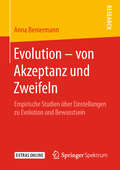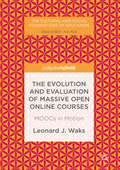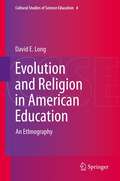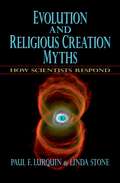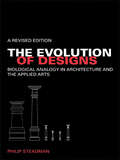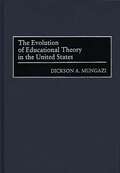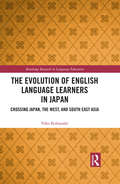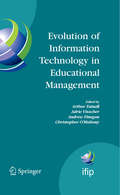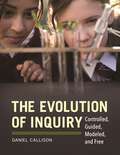- Table View
- List View
Evolution – von Akzeptanz und Zweifeln: Empirische Studien über Einstellungen zu Evolution und Bewusstsein
by Anna BeniermannAnna Beniermann gelingt es, erstmals Daten zur Akzeptanz der Evolution und der Evolution des menschlichen Bewusstseins bevölkerungsrepräsentativ zu erheben und im Kontext weiterer Faktoren – wie Gläubigkeit und die Sicht auf Gehirn und Geist –zu analysieren. Die Autorin stellt fest, dass Einstellungen zu Evolution und deren Verhältnis zu religiöser Gläubigkeit und dualistischem Denken vielschichtiger und komplexer sind als oft angenommen und in vorangegangenen Studien dargestellt. Insbesondere ist die häufig vorgenommene Kategorisierung in die Ansichten Kreationismus, Theistische Evolution und Naturalismus nicht ausreichend. Derartige Klassifizierungen können geradezu irreführend sein.
The Evolution and Evaluation of Massive Open Online Courses: MOOCs in Motion (The Cultural and Social Foundations of Education)
by Leonard J. WaksWinner of the Outstanding Book Award (Society for Professors of Education)This book offers a re-assessment of the educational and occupational value of MOOCs based on developments since 2013. When MOOCs appeared--amidst great fanfare in 2012, leaders proclaimed an educational “revolution.” By 2013, however, dramatic failures, negative research findings, and sharp critiques ended the MOOC hype. This book examines both MOOCs and prior distance learning innovations, and offers a broad overview of their educational, economic and social effects. Chapters explore ties between MOOCs and emerging pedagogical models as well as exponentially rising tuition rates, student debt, and chronic underemployment of university graduates worldwide. It offers readers a comprehensive, up-to-the-moment guide to the MOOC phenomenon.
Evolution and Religion in American Education: An Ethnography (Cultural Studies of Science Education #4)
by David E. LongEvolution and Religion in American Education shines a light into one of America’s dark educational corners, exposing the regressive pedagogy that can invade science classrooms when school boards and state overseers take their eyes off the ball. It sets out to examine the development of college students’ attitudes towards biological evolution through their lives. The fascinating insights provided by interviewing students about their world views adds up to a compelling case for additional scrutiny of the way young people’s educational experiences unfold as they consider—and indeed in some cases reject—one of science’s strongest and most cogent theoretical constructs. Inevitably, open discussion and consideration of the theory of evolution can chip away at the mental framework constructed by Creationists, eroding the foundations of their faith. The conceptual battleground is so fraught with logical challenges to Creationist dogma that in a number of cases students’ exposure to such dangerous ideas is actively prevented. This book provides a detailed map of this astonishing struggle in today’s America—a struggle many had thought was done and dusted with the onset of the Enlightenment.
Evolution and Religious Creation Myths: How Scientists Respond
by Paul F. Lurquin Linda StoneRelying mostly on modern genetic science, this book exposes how various forms of creationism-including intelligent design-fail to provide testable models for the appearance and evolution of life. On the contrary, science has been very successful in the description of the unguided processes that led to the creation of the universe and one of its consequences, the appearance of life forms, including humans.
Evolution and Religious Creation Myths: How Scientists Respond
by Linda Stone Paul F. LurquinRelying mostly on modern genetic science, this book exposes how various forms of creationism-including intelligent design-fail to provide testable models for the appearance and evolution of life. On the contrary, science has been very successful in the description of the unguided processes that led to the creation of the universe and one of its consequences, the appearance of life forms, including humans.
Evolution Education Around the Globe
by Hasan Deniz Lisa A. BorgerdingThis edited book provides a global view on evolution education. It describes the state of evolution education in different countries that are representative of geographical regions around the globe such as Eastern Europe, Western Europe, North Africa, South Africa, North America, South America,Middle East, Far East, South East Asia, Australia, and New Zealand.Studies in evolution education literature can be divided into three main categories: (a) understanding the interrelationships among cognitive, affective, epistemological, and religious factors that are related to peoples’ views about evolution, (b) designing, implementing, evaluating evolution education curriculum that reflects contemporary evolution understanding, and (c) reducing antievolutionary attitudes. This volume systematically summarizes the evolution education literature across these three categories for each country or geographical region. The individual chapters thus include common elements that facilitate a cross-cultural meta-analysis. Written for a primarily academic audience, this book provides a much-needed common background for future evolution education research across the globe.
Evolution Education in the American South: Culture, Politics, and Resources in and around Alabama
by Christopher D. Lynn Amanda L. Glaze William A. Evans Laura K. ReedThis volume reaches beyond the controversy surrounding the teaching and learning of evolution in the United States, specifically in regard to the culture, politics, and beliefs found in the Southeast. The editors argue that despite a deep history of conflict in the region surrounding evolution, there is a wealth of evolution research taking place—from biodiversity in species to cultural evolution and human development. In fact, scientists, educators, and researchers from around the United States have found their niche in the South, where biodiversity is high, culture runs deep, and the pace is just a little bit slower.
Evolution Education Re-considered: Understanding What Works
by Ute Harms Michael J. ReissThis collection presents research-based interventions using existing knowledge to produce new pedagogies to teach evolution to learners more successfully, whether in schools or elsewhere. ‘Success’ here is measured as cognitive gains, as acceptance of evolution or an increased desire to continue to learn about it. Aside from introductory and concluding chapters by the editors, each chapter consists of a research-based intervention intended to enable evolution to be taught successfully; all these interventions have been researched and evaluated by the chapters’ authors and the findings are presented along with discussions of the implications. The result is an important compendium of studies from around the word conducted both inside and outside of school. The volume is unique and provides an essential reference point and platform for future work for the foreseeable future.
The Evolution of American Women’s Studies: Reflections on Triumphs, Controversies, and Change
by A. GinsbergThis book is comprised of reflections by diverse women's studies scholars, focusing on the many ways in which the field has evolved from its first introduction in the University setting to the present day.
The Evolution of Deficit Thinking: Educational Thought and Practice
by Richard R. ValenciaDeficit thinking refers to the notion that students, particularly low income minority students, fail in school because they and their families experience deficiencies that obstruct the leaning process (e.g. limited intelligence, lack of motivation, inadequate home socialization). Tracing the evolution of deficit thinking, the authors debunk the pseudo-science and offer more plausible explanations of why students fail.
The Evolution of Deficit Thinking: Educational Thought and Practice (Stanford Series On Education And Public Policy Ser. #Vol. 19)
by Richard R. ValenciaDeficit thinking refers to the notion that students, particularly low income minority students, fail in school because they and their families experience deficiencies that obstruct the leaning process (e.g. limited intelligence, lack of motivation, inadequate home socialization). Tracing the evolution of deficit thinking, the authors debunk the pseudo-science and offer more plausible explanations of why students fail.
The Evolution of Designs: Biological Analogy in Architecture and the Applied Arts
by Philip SteadmanThis book tells the history of the many analogies that have been made between the evolution of organisms and the human production of artefacts, especially buildings. It examines the effects of these analogies on architectural and design theory and considers how recent biological thinking has relevance for design. Architects and designers have looked to biology for inspiration since the early 19th century. They have sought not just to imitate the forms of plants and animals, but to find methods in design analogous to the processes of growth and evolution in nature. This new revised edition of this classic work adds an extended Afterword covering recent developments such as the introduction of computer methods in design in the 1980s and ‘90s, which have made possible a new kind of ‘biomorphic’ architecture through ‘genetic algorithms’ and other programming techniques.
The Evolution of Designs: Biological Analogy in Architecture and the Applied Arts
by Philip SteadmanThis book tells the history of the many analogies that have been made between the evolution of organisms and the human production of artefacts, especially buildings. It examines the effects of these analogies on architectural and design theory and considers how recent biological thinking has relevance for design. Architects and designers have looked to biology for inspiration since the early 19th century. They have sought not just to imitate the forms of plants and animals, but to find methods in design analogous to the processes of growth and evolution in nature. This new revised edition of this classic work adds an extended Afterword covering recent developments such as the introduction of computer methods in design in the 1980s and ‘90s, which have made possible a new kind of ‘biomorphic’ architecture through ‘genetic algorithms’ and other programming techniques.
The Evolution of Educational Theory in the United States
by Dickson Mungazi [Deceased]There is no better way to understand a society's assessment of its own success or failure than an examination of its theories of education, because any attempt to improve national performance will be reflected in educational policy. This study is a comprehensive account of the evolution of American educational theory from the colonial period to the present. It includes a broad discussion of the foundations upon which early Americans built their educational policy, as well as influential factors unique to the American experience. From the Revolution to nineteenth century reform efforts to the turbulent twentieth century, educational theory has been adapted to suit the needs of an ever-changing, multicultural society.Throughout U.S. history key objectives have affected the character of education, particularly curriculum. One main thrust for reform has been the belief that equality in education serves the national interest. Examination of the historical attitudes toward the education of African Americans provides a valuable insight into this process. Today America is experiencing significant difficulties in making its educational system succeed, and the negative social effects of this deterioration are already apparent. The future success of educational theory lies in international cooperative efforts.
The Evolution of English Language Learners in Japan: Crossing Japan, the West, and South East Asia (Routledge Research in Language Education)
by Yoko KobayashiThis book seeks a better understanding of the sociocultural and ideological factors that influence English study in Japan and study-abroad contexts such as university-bound high schools, female-dominant English classes at college, ESL schools in Canada, and private or university-affiliated ESL programs in Singapore and Malaysia. The discussion is based not only on data garnered from Japanese EFL learners and Japanese/overseas educators but also on official English language policies and commercial magazine discourses about English study for Japanese people. The book addresses seemingly incompatible themes that are either entrenched in or beyond Japan’s EFL context such as: Japan’s decades-long poorly-performing English education vs. its equally long-lived status as an economic power; Japanese English learners’ preference for native English speakers/norms in at-home Japanese EFL contexts vs. their friendship with other Asian students in western study-abroad contexts; Japanese female students’ dream of using English to further their careers vs. Japanese working women’s English study for self-enrichment; Japanese society’s obsession with globalization through English study vs. the Japanese economy sustained by monolingual Japanese businessmen; Japanese business magazines’ frequent cover issues on global business English study vs. Japanese working women’s magazines’ less frequent and markedly feminized discourses about English study.
The Evolution of English Language Learners in Japan: Crossing Japan, the West, and South East Asia (Routledge Research in Language Education)
by Yoko KobayashiThis book seeks a better understanding of the sociocultural and ideological factors that influence English study in Japan and study-abroad contexts such as university-bound high schools, female-dominant English classes at college, ESL schools in Canada, and private or university-affiliated ESL programs in Singapore and Malaysia. The discussion is based not only on data garnered from Japanese EFL learners and Japanese/overseas educators but also on official English language policies and commercial magazine discourses about English study for Japanese people. The book addresses seemingly incompatible themes that are either entrenched in or beyond Japan’s EFL context such as: Japan’s decades-long poorly-performing English education vs. its equally long-lived status as an economic power; Japanese English learners’ preference for native English speakers/norms in at-home Japanese EFL contexts vs. their friendship with other Asian students in western study-abroad contexts; Japanese female students’ dream of using English to further their careers vs. Japanese working women’s English study for self-enrichment; Japanese society’s obsession with globalization through English study vs. the Japanese economy sustained by monolingual Japanese businessmen; Japanese business magazines’ frequent cover issues on global business English study vs. Japanese working women’s magazines’ less frequent and markedly feminized discourses about English study.
Evolution of Information Technology in Educational Management (IFIP Advances in Information and Communication Technology #292)
by Andrew Finegan Christopher O'Mahony Arthur Tatnall Adrie J. VisscherEvolution of Information Technology in Educational Management As the editors of this volume we are very happy to publish a selection of the papers that were presented at the eighth Conference of Working Group 3.7 of the International Federation for Information Processing which was held in July 2008. The focus of Working Group 3.7 is on ITEM: Information Technology in Educational Management (for more information, please visit our website http://item.wceruw.org/), and the theme of its 2008 conference was on the Evolution of Information Technology in Educational Management. Our Working Group started its activities (officially we were not an IFIP Working Group at that time) in 1994 in Israel, so it made sense to look at how ITEM has evolved over the years and to reflect on what its future may be. The conference took place in Darwin (northern Australia) which even during the Australian winter is a very pleasant location for having a conference. The town of Darwin was given its name by the Captain of the Beagle (the ship on which Darwin travelled when he made the investigations on which he based his Theory of Evolution) who came to the area and named the town after the giant of science he admired.
The Evolution of Inquiry: Controlled, Guided, Modeled, and Free
by Daniel CallisonDefining the progression toward inquiry learning, this book provides an extensive overview of the past five decades and the evolution of inquiry in science, history, language arts, and information literacy studies.Information inquiry is a basic skill for those who examine information as a science, and its principles can be applied across the K-12 curriculum. Built around reflective reviews of more than two dozen articles from School Library (Media Activities) Monthly, this helpful book shows the evolution, adoption, and application of the inquiry learning process to the school library teaching/learning environment. Four levels of inquiry—controlled, guided, open, and free—are explored in association with the emerging national Common Core curriculum and the Standards for the 21st-Century Learner from the American Association of School Librarians. With the growing interest in the concept of inquiry and inquiry learning, you may find yourself needing to distinguish between the existing models and their applications. To help you do that, the book provides you with rich, historical context that clarifies the models, and it also projects future applications of inquiry and learner-centered teaching through school information literacy programs. These new applications, such as graphic inquiry, argumentation for inquiry, and the student as information scientist, offer tangible examples you can use to enrich the expanding information literacy curriculum.
The Evolution of Inquiry: Controlled, Guided, Modeled, and Free (Slm Hot Topics Ser.)
by Daniel CallisonDefining the progression toward inquiry learning, this book provides an extensive overview of the past five decades and the evolution of inquiry in science, history, language arts, and information literacy studies.Information inquiry is a basic skill for those who examine information as a science, and its principles can be applied across the K-12 curriculum. Built around reflective reviews of more than two dozen articles from School Library (Media Activities) Monthly, this helpful book shows the evolution, adoption, and application of the inquiry learning process to the school library teaching/learning environment. Four levels of inquiry—controlled, guided, open, and free—are explored in association with the emerging national Common Core curriculum and the Standards for the 21st-Century Learner from the American Association of School Librarians. With the growing interest in the concept of inquiry and inquiry learning, you may find yourself needing to distinguish between the existing models and their applications. To help you do that, the book provides you with rich, historical context that clarifies the models, and it also projects future applications of inquiry and learner-centered teaching through school information literacy programs. These new applications, such as graphic inquiry, argumentation for inquiry, and the student as information scientist, offer tangible examples you can use to enrich the expanding information literacy curriculum.
The Evolution of Liberal Arts in the Global Age
by Peter Marber Daniel ArayaAdvanced and developing countries across the globe are embracing the liberal arts approach in higher education to foster more innovative human capital to compete in the global economy. Even as interest in the tradition expands outside the United States, can the democratic philosophy underlying the liberal arts tradition be sustained? Can developing countries operating under heavy authoritarian systems cultivate schools predicated on open discussion and debate? Can entrenched specialist systems in Europe and Asia successfully adopt the multidisciplinary liberal arts model? These are some of the questions put to leading scholars and senior higher education practitioners within this edited collection. Beginning with historical context, international contributors explore the contours of liberal arts education amid public calls for change in the United States, the growing global interest in the approach outside the United States, as well as the potential of liberal arts philosophy in a global knowledge economy.
The Evolution of Liberal Arts in the Global Age
by Peter Marber Daniel ArayaAdvanced and developing countries across the globe are embracing the liberal arts approach in higher education to foster more innovative human capital to compete in the global economy. Even as interest in the tradition expands outside the United States, can the democratic philosophy underlying the liberal arts tradition be sustained? Can developing countries operating under heavy authoritarian systems cultivate schools predicated on open discussion and debate? Can entrenched specialist systems in Europe and Asia successfully adopt the multidisciplinary liberal arts model? These are some of the questions put to leading scholars and senior higher education practitioners within this edited collection. Beginning with historical context, international contributors explore the contours of liberal arts education amid public calls for change in the United States, the growing global interest in the approach outside the United States, as well as the potential of liberal arts philosophy in a global knowledge economy.
The Evolution of Life: Teaching, Learning and Training - New Approaches on Current Research in the Didactics of Evolution
by Corinne Fortin Julie GobertThe aim of this collective work is to give an account of the topicality and dynamics of new research in the didactics of evolution, by articulating francophone and international work. The various contributions pursue a reflection on the challenges of teaching and learning about evolution, based on historical, epistemological and societal approaches. The themes addressed illustrate the vitality and diversity of research issues in educational sciences, from primary school to university. Structured around different theoretical fields (problematization, didactics of the curriculum, nature of science, etc.), this book explores the content, teaching and learning processes and approaches, teaching practices, as well as pre-service and in-service teacher training, with a view to both intelligibility and feasibility.
The Evolution of Life: Teaching, Learning and Training - New Approaches on Current Research in the Didactics of Evolution
by Corinne Fortin Julie GobertThe aim of this collective work is to give an account of the topicality and dynamics of new research in the didactics of evolution, by articulating francophone and international work. The various contributions pursue a reflection on the challenges of teaching and learning about evolution, based on historical, epistemological and societal approaches. The themes addressed illustrate the vitality and diversity of research issues in educational sciences, from primary school to university. Structured around different theoretical fields (problematization, didactics of the curriculum, nature of science, etc.), this book explores the content, teaching and learning processes and approaches, teaching practices, as well as pre-service and in-service teacher training, with a view to both intelligibility and feasibility.
The Evolution of Research on Teaching Mathematics: International Perspectives in the Digital Era (Mathematics Education in the Digital Era #22)
by Agida Manizade Nils Buchholtz Kim BeswickThis open access book investigates current issues related to the evolution of research on teaching mathematics and examines up to thirty years of presage-process-product research (PPPR) in mathematics with respect to conceptualization, instrumentation, and design. The book discusses the theoretical and methodological challenges associated with PPPR, critically reviews current research, and explores the likely direction of further developments to identify future paths for research on high-quality mathematics teaching in the digital era. Subjects that are covered in this work focus on the relationships between 1) student learning outcomes measured upon completion of the mathematics teaching; 2) student learning activities in the classroom; 3) interactive mathematics teacher activities, and best practices in mathematics classrooms conducted in the presence of students; 4) pre-post-active mathematics teacher activities such as planning, assessment, and other teaching-related activities outside of the classroom; 5) mathematics teachers’ competencies, knowledge, and skills; and 6) mathematics teachers’ characteristics, including beliefs, attitudes, and motivation. This book discusses the evolution of such research in mathematics teaching and teacher education in the digital era and is of interest to researchers exploring the field of mathematics teaching and mathematics teacher education as well as educators.
The Evolution of School Disturbance in America: Colonial Times to Modern Day
by M. Reid Counts Gordon A. CrewsThis work is a cross-sectional analysis of school disturbance as it has evolved from the inception of schools in colonial America. In their introduction, the authors provide a general overview of American school disturbance, the extent of their disturbances, and possible causes. They then examine the topic in detail, with chapters on disturbances in the Colonial period, the Early National period, the Common School period, the Progressive period, and the Kaleidoscopic period.By examining how school disturbances relate to social and educational developments, Crews and Counts provide a valuable research and teaching tool for courses in criminal justice foundations, juvenile issues, and educational foundations.
